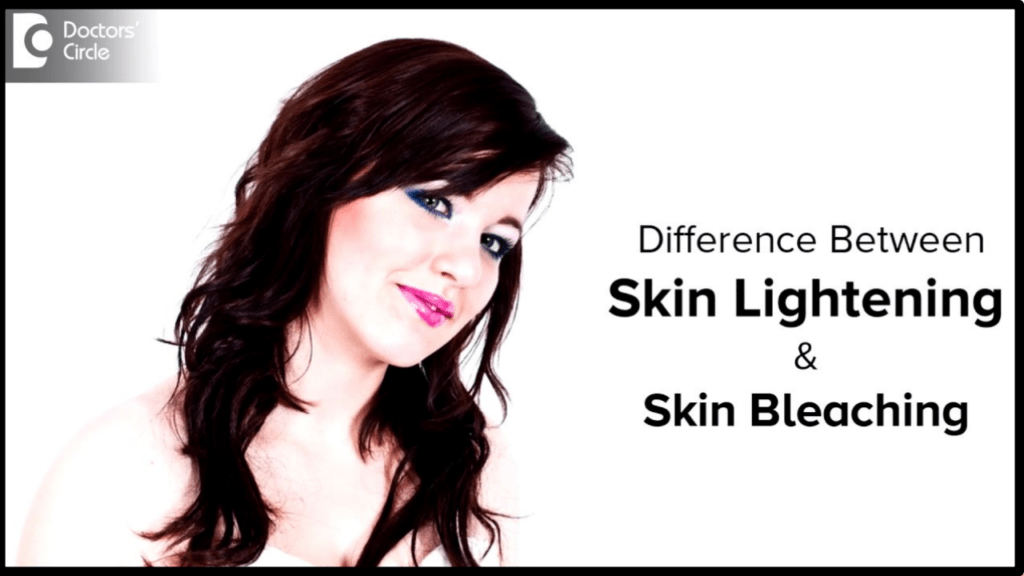In this article, I will tell you about the difference between skin lightening and skin brightening also read this article completely to know what is skin lightening and what are the types of skin brightening.
What Is Skin Lightening?
Skin lightening, also known as skin whitening or skin bleaching, refers to the practice of using cosmetic products or procedures to lighten the skin tone or reduce the visibility of skin blemishes, such as freckles, age spots, and hyperpigmentation.
These products may contain ingredients such as hydroquinone, glycolic acid, kojic acid, arbutin, or vitamin C, which are believed to inhibit the production of melanin, the pigment that gives colour to the skin.
Some skin-lightening products can be used topically, while others may require a prescription from a doctor and may be taken orally.
It’s important to note that skin lightening can have potential side effects and risks, and it is not recommended by dermatologists for long-term use. Additionally, skin lightening has been criticized for perpetuating harmful cultural norms and promoting a Eurocentric standard of beauty.
It is important to consider these factors before using skin-lightening products or undergoing any procedures.
Types Of Skin Lightening
There are several types of skin-lightening treatments, including:
- Topical creams and gels: These products contain lightening agents such as hydroquinone, kojic acid, or glycolic acid and are applied directly to the skin.
- Chemical peels: Chemical peels use a solution to remove the top layer of the skin, revealing lighter and smoother skin underneath.
- Microdermabrasion: Microdermabrasion is a mechanical exfoliation procedure that removes the top layer of dead skin cells, making the skin look brighter and more even in tone.
- Laser treatment: Laser treatment can target specific areas of hyperpigmentation and remove the excess pigment to lighten the skin.
- Intense Pulsed Light (IPL) therapy: IPL therapy uses intense pulsed light to target specific areas of hyperpigmentation and reduce their appearance.
- Oral medications: Some prescription medications, such as corticosteroids or topical retinoids, can be used to lighten the skin, although they may have side effects and should only be used under the supervision of a doctor.
It’s important to note that some skin-lightening treatments can have potential side effects, including skin irritation, redness, itching, and increased sensitivity to the sun. Additionally, some skin-lightening treatments may not be suitable for all skin types or may not be effective for certain types of hyperpigmentation. Before undergoing any skin-lightening treatment, it is important to consult a dermatologist to determine the best course of action for your skin.
What Is Skin Brightening?
Skin brightening, also known as skin radiance, refers to the use of cosmetic products or treatments to improve the overall appearance of the skin and make it look brighter, clearer, and more radiant.
Unlike skin lightening, which is specifically designed to lighten the skin tone, skin brightening focuses on improving the overall health and appearance of the skin, regardless of its natural skin tone.
Skin brightening treatments can include:
- Exfoliation: Gentle exfoliation can help remove dead skin cells and promote skin cell turnover, making the skin look brighter and more radiant.
- Hydration: drinking plenty of water and using hydrating products can help to plump up the skin and improve its appearance.
- Antioxidants: Antioxidants, such as Vitamin C, can help to protect the skin from damage caused by free radicals and improve its overall health and appearance.
- Sun protection: Using broad-spectrum sunscreen can help to protect the skin from harmful UV rays and prevent damage that can make the skin look dull and lifeless.
- Light therapy: Light therapy, such as LED light therapy, can help boost collagen production and improve the overall appearance of the skin.
It’s important to note that skin brightening is a gentler approach to improving the appearance of the skin and is not associated with the potential risks and side effects associated with skin lightening treatments. Additionally, skin brightening can be suitable for all skin types and is not limited to a specific skin tone.
Types Of Skin Brightening
There are several types of skin brightening treatments, including:
- Topical creams and serums: These products contain ingredients such as Vitamin C, kojic acid, niacinamide, or arbutin, which can help brighten the skin and improve its overall appearance.
- Facials: Facials can include exfoliation, hydration, and the application of brightening ingredients to help improve the appearance of the skin.
- Microdermabrasion: Microdermabrasion is a gentle exfoliation treatment that removes the top layer of dead skin cells to reveal brighter, more radiant skin underneath.
- Chemical peels: Chemical peels use a solution to remove the top layer of the skin, promoting cell turnover and helping to brighten the skin.
- Light therapy: Light therapy, such as LED light therapy, can help boost collagen production, improve the overall health of the skin, and give it a brighter, more radiant appearance.
- Laser treatments: Some laser treatments, such as photo facials, can help to reduce the appearance of dark spots, improve skin texture, and give the skin a brighter appearance.
It’s important to note that the best approach to skin brightening will depend on your skin type, concerns, and goals. Before undergoing any skin-brightening treatment,
it is important to consult a dermatologist or skincare professional to determine the best course of action for your skin.
Difference between skin lightening and skin brightening?
Skin lightening and skin brightening are terms often used interchangeably, but they refer to slightly different concepts.
Skin lightening refers to the practice of reducing the melanin content in the skin, leading to a lighter complexion. This is often done for cosmetic reasons, as lighter skin is sometimes considered more desirable in certain cultures. Some people use skin-lightening products and treatments to address hyperpigmentation, age spots, freckles, and other dark spots on their skin. However, skin lightening can also have negative health effects and can lead to skin damage if done incorrectly or with harsh products.
Skin brightening, on the other hand, refers to the process of improving the overall radiance and luminosity of the skin. This can be achieved through the use of products and treatments that exfoliate and hydrate the skin, even out skin tone, and reduce the appearance of dark spots and other imperfections. Unlike skin lightening, skin brightening does not aim to change the actual skin color, but rather to enhance the natural skin complexion and create a brighter, more youthful appearance.
In conclusion, skin lightening focuses on reducing the skin’s melanin content to achieve a lighter skin tone, while skin brightening aims to enhance the natural complexion and radiance of the skin without changing its colour.


